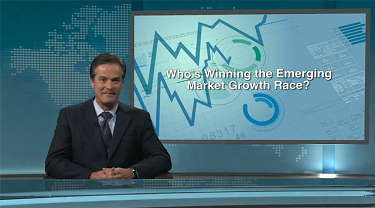Global growth is accelerating. After years of disappointment, where forecasters seemed to be regularly revising their growth predictions downward, suddenly a flip-flop: projections are now regularly being revised upward, starting with the developed world. And after all the post-recession accolades that were piled on to emerging markets just a few years ago, they seem to be taking a bit of a back seat in current economic banter. Is the emerging world reviving too, and if so, which are the leaders?
First, a little context. In the aftermath of the Great Recession, key emerging markets joined – and some led – the avalanche of public stimulus, unleashed in an effort to save the planet from a massive economic collapse. Their need to maintain stability was likely more acute than that of the developed world, as their systems were calibrated to an expectation of very aggressive growth. A sudden interruption would have been too politically risky, disrupting the general population and the businesses that sustain it. As such, in many emerging market cases, stimulus was a far greater share of GDP than for the developed world. Governments who couldn’t or wouldn’t pay up suffered the consequences, with some seeing outright regime change.
For those who spent the big bucks, it worked well – almost too well – but the big problem then became choosing when to turn the taps off. In certain key cases, notably China, they are still trying to ease back. Clearly, for many emerging economies, superior post-recession growth was a bit of a mirage, one that is now giving way to a sustainable reality, thanks to the pickup in global activity. So, who are the leaders in this renewed race?
Recent GDP figures seem to put India in the lead. Success with reforms dulled growth temporarily in 2017 as the economy absorbed the one-off impacts, but most analysts see sustainable annual growth above 7 per cent. As it weans itself off public stimulus, China is also outperforming expectations. First-quarter growth surprised on the upside at an annualized 6.8 per cent, sparking upward revisions for the year. Vietnam remains red-hot, ringing in at the upper-6-per-cent level, along with the Philippines. The Asian tiger economies are doing well, although growth is not as hot. Industrialized Asian growth rates look more like those on the upper end of the developed markets.
Eastern European economies seemed to collectively have a good year in 2017 following years of sluggish post-recession growth. Recent success is likely due to Western Europe’s 2017 revival. As growth is carrying forward into 2018, Eastern European economies should benefit again. However, growth there is quite a bit behind the hot growth zones in Asia.
Latin America is lagging the rest, likely held back by Brazil’s economic and political woes, and not helped by Venezuela’s troubles. Even so, there are bright spots in Central America, and Peru is consistently generating impressive growth well above the regional average. The Middle East and Africa are generally soft, with very occasional bright spots.
There is cause for optimism in emerging markets in more recent figures. Purchasing managers across the emerging world are indicating an improvement in their perception of market conditions in the coming six months, trailing the very positive upturn in the developed world, but clearly moving in the right direction. Singapore, a regional bellwether, is showing a solid increase in total-economy buyer sentiment, sparked by the largest and most steady increase in new orders in the past seven years. China has also seen a notable improvement in sentiment.
Over the coming months, trade indicators are the likely tell-tale statistic of progress. It’s the flow of trade, lifted by the developed world, that’s giving rise to recent emerging market activity. The engine economies are doing their jobs. But two key factors could be disruptors: first, the rise in protectionist uncertainty, now being stoked by concrete anti-trade policies; and second, the tightening of liquidity, which is beginning to impact financial market stability in the more exposed emerging markets. We will be watching these very carefully in the coming weeks and months.
Emerging market growth is following the lead of the developed world. Revived growth is spreading, and optimism is building in a way we have not seen for a number of years. Given the presence of significant pent-up demand in OECD nations, the pick-up in emerging market growth is likely to last.





